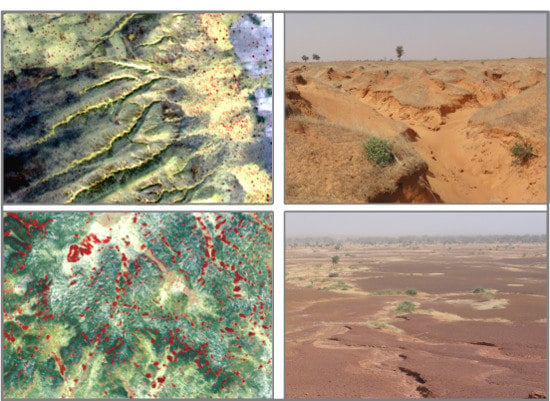What Four Decades of Earth Observation Tell Us about Land Degradation in the Sahel?
Abstract
:1. Introduction
2. The Sahel Context
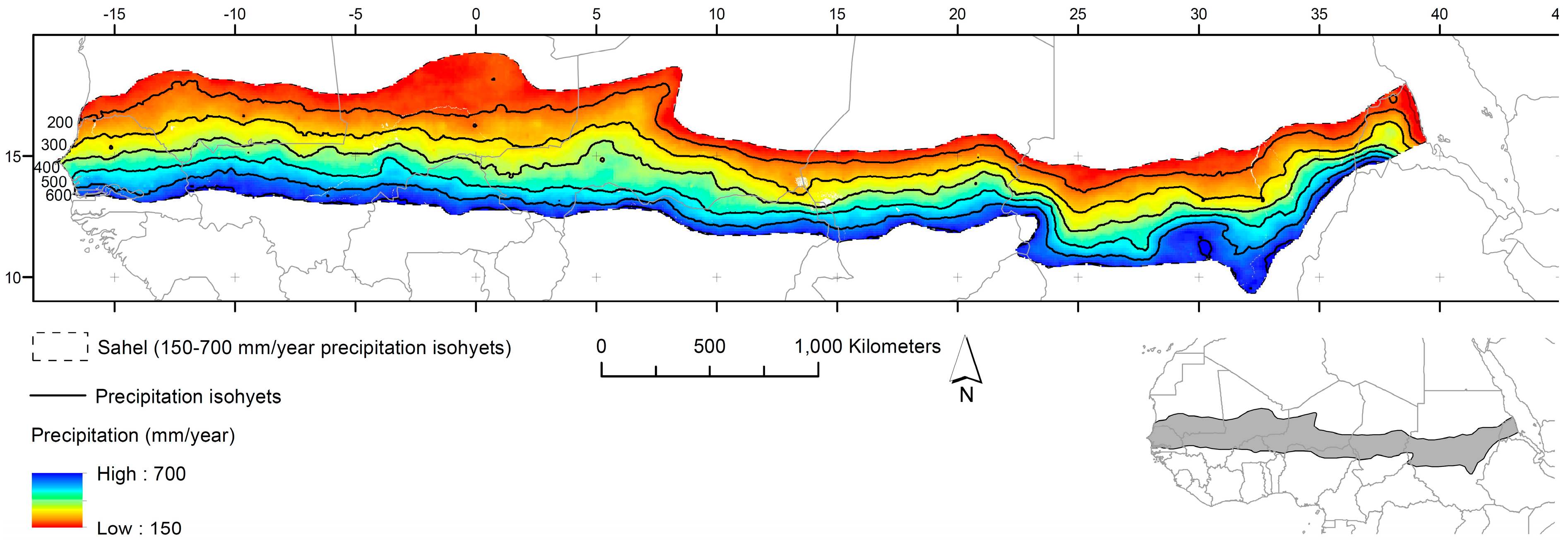
3. Direction and Determinants of Land Degradation
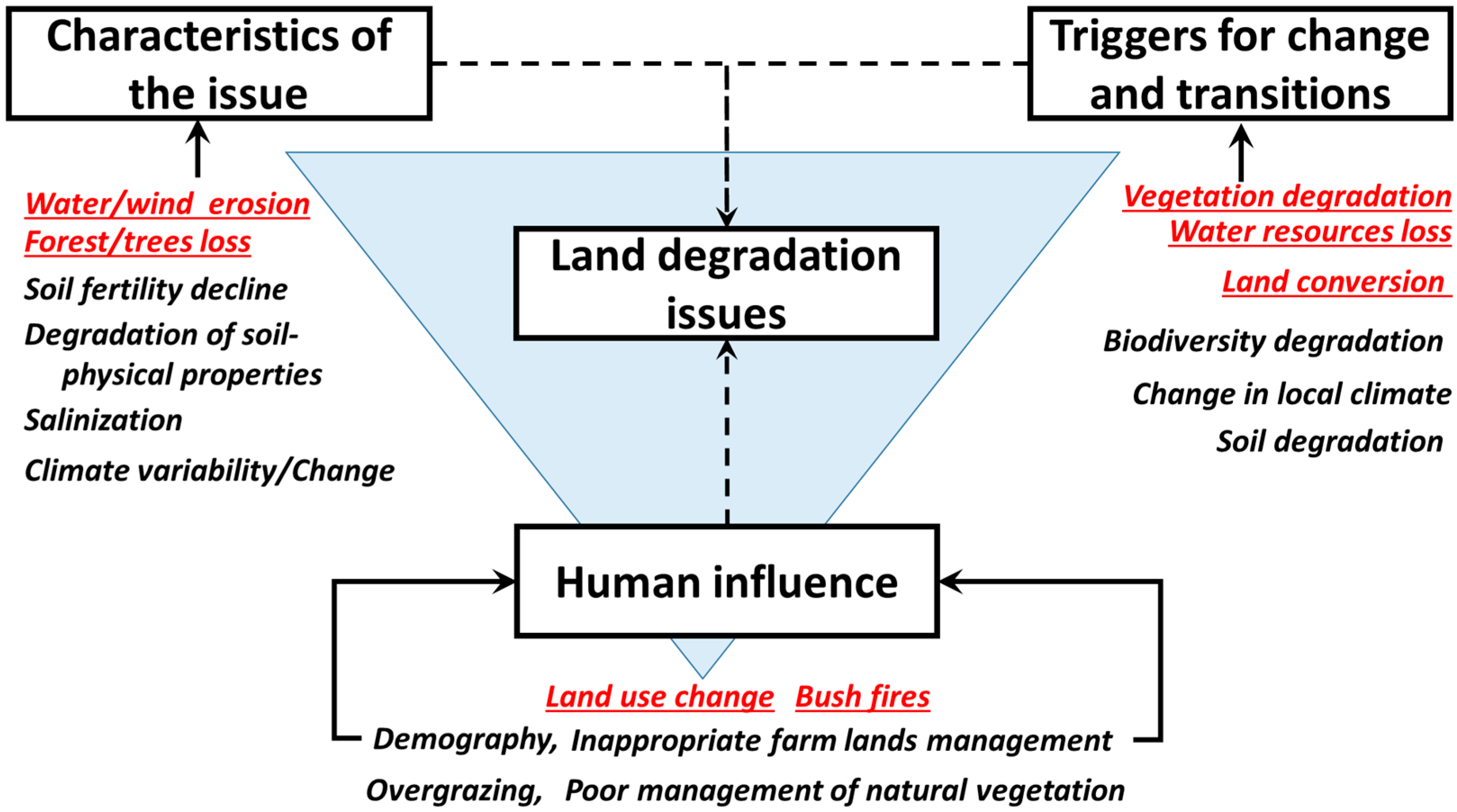
4. Remote Sensing Based Assessment of Land Degradation Dynamics in the Sahel
4.1. Assessing Degradation
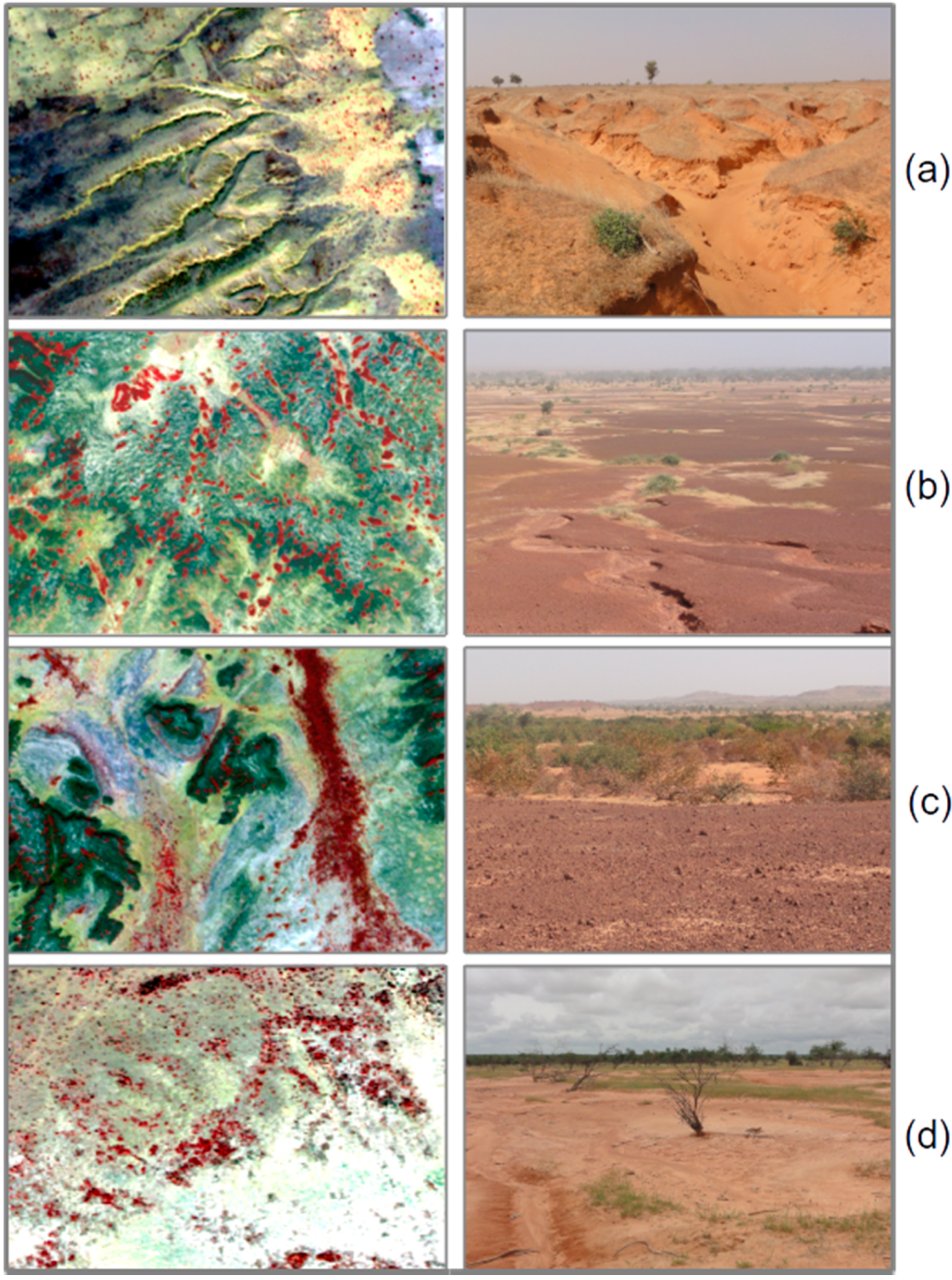
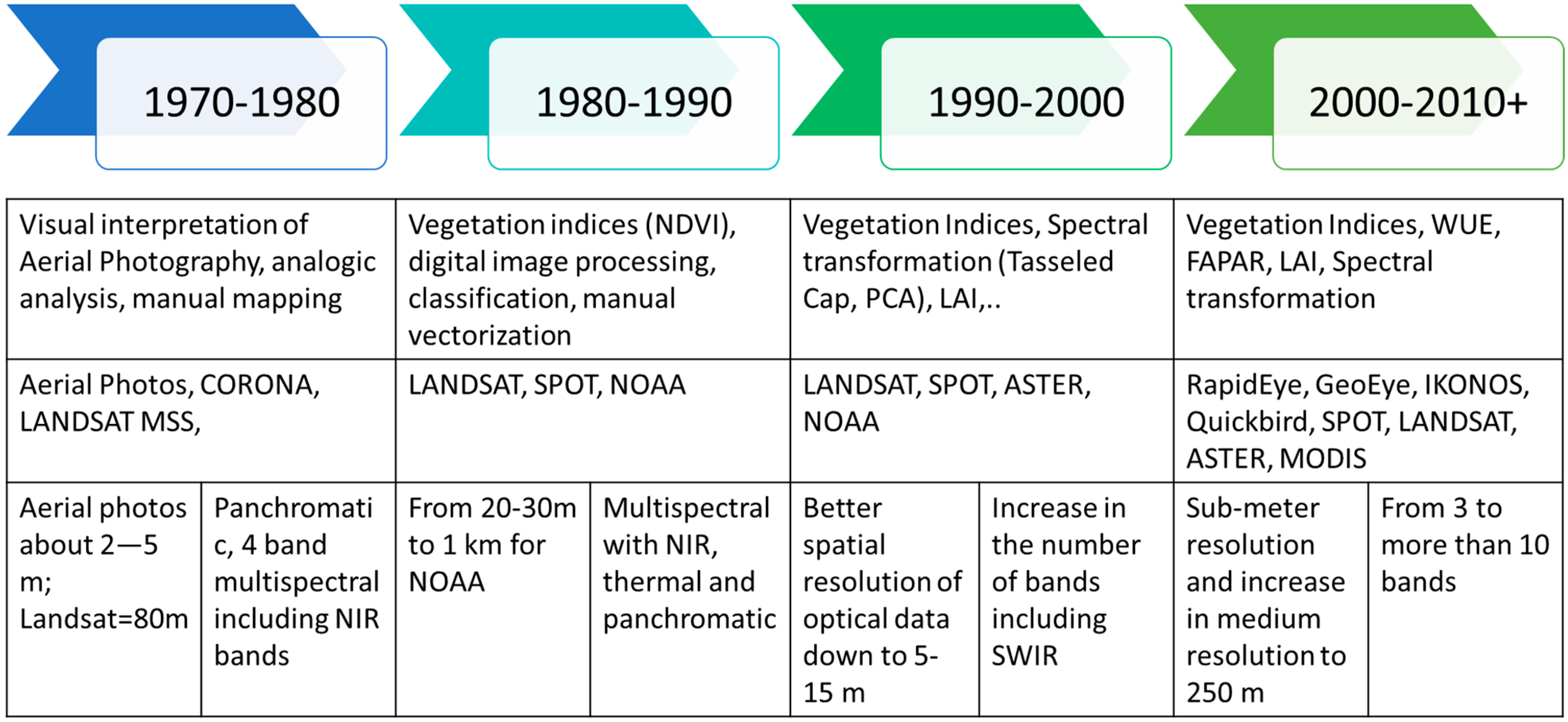
4.2. The Greening Sahel Phenomenon

| Study | NDVI/ Biomass | NDVI/ Rainfall | NDVI Trend | Data | Period | Area |
|---|---|---|---|---|---|---|
| Tagesson et al. [40] | - | r² = 0.39 | no trend | in situ NDVImax | 2002–2012 | Dahra, Senegal |
| Rasmussen et al. [34] | - | r² = 0.29 | - | MODIS, NDVI growing season | 2000–2012 | Northern Burkina Faso |
| Dardel et al. [17] | r² = 0.59/0.38 | - | 0.05/−0.04 units/period | GIMMS3g growing season, herb biomass | 1984–2011/ 1994–2011 | Gourma, Mali/Fakara, Niger |
| Brandt et al. [52] | r² = 0.57 | r² = 0.78 | 36%/period | LTDR/VGT sum, TAMSAT, herb + leaf biomass | 1987–2013 | Senegal |
| Meroni et al. [41] | r² = 0.34 | - | - | VGT FAPAR, herb biomass | 1998–2013 | Matam, Senegal |
| Anyamba et al. [46] | - | r² = 0.38 | - | GIMMS-3g and various rainfall data sources | 1983–2012 | all Sahel |
| Fensholt et al. [61] | - | r² = 0.42 | 0.046 | GIMMS3g sum | 1982–2010 | all Sahel |
| Mbow et al. [36] | r² = 0.39 | - | - | in situ NDVI, biomass | 2006–2010 | Dahra, Senegal |
| Fensholt et al. [65] | - | most pixels r² < 0.5 | - | GIMMS NDVI, GPCP | 1981–2007 | all Sahel |
| Fensholt et al. [66] | r² = 0.49/0.37 | - | - | MODIS C4/C4-5 NPP, biomass | 2001 | Dahra, Senegal |
| Li et al. [67] | - | r² = 0.89 /0.71/0.73/0.3 | - | GIMMS NDVI | 1982–1997 | stepps/ agriculture/savanna/woodland Senegal |
5. Data Limitations and Prospects of Remote Sensing Applications for Land Degradation
| Degradation Indicator | Examples of EO Applications | Data Example | Limitations | Example Study |
|---|---|---|---|---|
| Trends in greenness | Vegetation greenness time series linear trend analysis | AVHRR (GIMMS-3g) | Does not distinguish between crops, trees, grass, species; depends mostly on rainfall; driver of change remains unclear; coarse data mixes various processes | Dardel et al. [17] |
| Land productivity | Rain use efficiency, NPP | AVHRR, VGT, MODIS | Mixed pixels, unreliable rainfall data, quality of production unknown, translation to biomass highly dependant to environmental conditions | Fensholt and Rasmussen [78] |
| Land use/cover change | High resolution post-classification comparison | Landsat, Quickbird, ASTER | Dynamics and inter/intra-annual variability are hardly captured, no information on species | Mbow et al. [77] |
| Water use efficiency | Evapotranspiration | LTDR (AVHRR) | Does not distinguish between species; depends mainly on climate reanalysis (water and energy); driver of change remains unclear; coarse data mixes various processes | Marshall et al. [76] |
| Water resources degradation | Medium resolution time series classification | MODIS, Landsat | Cloud cover over water bodies; misclassifications due to similar spectral properties | Moser et al. [78] |
| Wind/water erosion, tree cover loss | High resolution visual inspection | Corona, Quickbird, RapidEye | Qualitative, hard to quantify, little information on species | Tappan et al. [50] |
6. Main Research Gaps in Assessing Trends in Land Degradation in the Sahel-Sudan
- There are major gaps for well-documented, comparable, time series of key indicators for many ecosystem features that increase the knowledge of the condition and trends on land degradation in the Sahel. This long-term survey data comparison requires a multi-scale and multi-thematic connection of many studies. Recent attempts have been done by Dardel et al. [17] and Brandt et al. [52] to harness long-term connection of satellite observations with field data on vegetation diversity and productivity.
- After many decades of remote sensing application in the Sahel, capacities are still limited for a rigorous and consistent monitoring of land use and land cover change. The Senegalese Centre de Suivi Ecologique (CSE) and the regional Center of AGRHYMET are among the very few examples of long-term efforts for quantifying land dynamics in the Sahel, because of the limited financial resources; and only then, these analyses are performed on a case study basis. Thus, many ground studies are restricted to few Sahelian countries (Table 1).
- Because of the scarcity of data—despite the declassification of LANDSAT archives—information on land degradation in drylands is quite poor and limits the ability to assess consistent baseline of the state of land degradation and desertification.
- There are some gaps on moderate spatial resolution LANDSAT archives. Specifically, no images are available in the USGS archive for the years 1976–1983 and 1989–1998 for the majority of path/rows [79], and these periods correspond with the severe droughts with obvious implication on land degradation. AVHRR data are considerably more abundant, but at a coarse resolution. This highlights the potential to use LANDSAT-AVHRR data fusion techniques (e.g., STAR-FM: Gao et al. [80]) to improve the spatio-temporal quantification of land dynamics.
- Differentiation of scales of the biophysical studies opposing remote sensing specialists and botanist on the ground lead to many inconsistent messages (degradation/recovery). This is underlined by Rasmussen et al. [75] as apparent contradiction that can affect how land dynamics are perceived in the area and what strategy is needed to be taken to reduce land degradation.
- Local perceptions of land degradation/improvements often disagree with EO analyses [55], and there is a need for more interdisciplinary studies. Remote sensing based analysis of land degradation focuses on using geospatial biophysical data only, while several new socioeconomic geospatial datasets now exist and could be integrated with these data giving a more comprehensive quantification of change [82].
7. Conclusions
Acknowledgments
Author Contributions
Conflicts of Interest
References
- UNCCD (UN Convention to Combat Desertification). Elaboration of an International Convention to Combat Desertification in Countries Experiencing Serious Drought and/or Desertification, Particularly in Africa. Available online: http://www.preventionweb.net/files/5650_convunccdeng.pdf (accessed on 15 December 2014).
- Oldeman, L.R.; Hakkeling, R.T.A.; Sombroek, W.G. World Map of the Status of Human-Induced Soil Degradation: An Explanatory Note; ISRIC: Wageningen, The Netherlands, 1990. [Google Scholar]
- Ickowicz, A.; Ancey, V.; Corniaux, C.; Duteurtre, G.; Poccard-Chappuis, R.; Touré, I.; Vall, E.; Wane, A. Crop-Livestock Production Systems in the Sahel—Increasing Resilience for Adaptation to Climate Change and Preserving Food Security. Available online: http://animalagclimatechange.org/wp-content/uploads/Building_Resilience_for_Adaptation.pdf#page=268 (accessed on 15 December 2014).
- Bai, Z.G.; Dent, D.L.; Olsson, L.; Schaepman, M.E. Global Assessment of Land Degradation and Improvement 1: Identification by Remote Sensing. Available online: http://www.isric.org/isric/webdocs/docs/Report%202008_01_GLADA%20international_REV_Nov%202008.pdf (accessed on 15 December 2014).
- Nachtergaele, F.O.; Licona-Manzur, C. The Land Degradation Assessment in Drylands (LADA) project: Reflections on indicators for land degradation assessment. In The Future of Drylands; Springer: New York, NY, USA, 2009; pp. 327–348. [Google Scholar]
- Reynolds, J.F.; Smith, D.M.S.; Lambin, E.F.; Turner, B.L.; Mortimore, M.; Batterbury, S.P.J.; Downing, T.E.; Dowlatabadi, H.; Fernandez, R.J.; Herrick, J.E.; et al. Global desertification: Building a science for dryland development. Science 2007, 316, 847–851. [Google Scholar] [CrossRef] [PubMed]
- Herrmann, S.M.; Hutchinson, C.F. The changing contexts of the desertification debate. J. Arid Environ. 2005, 63, 538–555. [Google Scholar] [CrossRef]
- Vlek, P.L.G.; Le, Q.B.; Tamene, L. Assessment of land degradation, its possible causes and threat to food security in Sub-Saharan Africa. In Food Security and Soil Quality; Taylor & Francis: Boca Raton, FL, USA, 2010; pp. 57–86. [Google Scholar]
- Riedacker, A. Climate change mitigation measures in the agroforestry sector and biodiversity future. In Proceedings of the Joint Workshop EEE Programme, ITCP, UNESCO-MAB, IIASA, ITCP, Trieste, Italy, 16–17 October 2006.
- Seto, K.C.; Reenberg, A. Rethinking Global Land Use in an Urban Era; MIT Press: Cambridge, MA, USA, 2014. [Google Scholar]
- Harrison, L.; Michaelsen, J.; Funk, C.; Marshall, M.; Tarnavsky, E.; Brown, M.E.; Husak, G.J. Crop water stress in a warming Sahel: Anticipating impacts with PET projections and a crop water balance model. 2015; Unpublished. [Google Scholar]
- Giannini, A.; Salack, S.; Lodoun, T.; Ali, A.; Gaye, A.T.; Ndiaye, O. A unifying view of climate change in the Sahel linking intra-seasonal, interannual and longer time scales. Environ. Res. Lett. 2013, 8. [Google Scholar] [CrossRef]
- Rasmussen, K. Land Degradation in the Sahel-Sudan: The Conceptual Basis. Available online: https://tidsskrift.dk/index.php/geografisktidsskrift/article/view/2579/4595 (accessed on 15 December 2014).
- Higginbottom, T.P.; Symeonakis, E. Assessing land degradation and desertification using vegetation index data: Current frameworks and future directions. Remote Sens. 2014, 6, 9552–9575. [Google Scholar] [CrossRef]
- Food and Agriculture Organization (FAO). Land Degradation Assessment in Drylands (LADA). Available online: http://www.unccd.int/en/programmes/Science/Monitoring-Assessment/Documents/PPT9-LADA%20lessons%20learned.pdf (accessed on 15 December 2014).
- Wessels, K.J.; van den Bergh, F.; Scholes, R.J. Limits to detectability of land degradation by trend analysis of vegetation index data. Remote Sens. Environ. 2012, 125, 10–22. [Google Scholar] [CrossRef]
- Dardel, C.; Kergoat, L.; Hiernaux, P.; Mougin, E.; Grippa, M.; Tucker, C.J. Re-greening Sahel: 30 Years of remote sensing data and field observations (Mali, Niger). Remote Sens. Environ. 2014, 140, 350–364. [Google Scholar] [CrossRef]
- L’Hote, Y.; Mahé, G.; Somé, B.; Triboulet, J.P. Analysis of a Sahelian annual rainfall index from 1896 to 2000; the drought continues. Hydrol. Sci. J. 2002, 47, 563–572. [Google Scholar] [CrossRef]
- Dregne, H.E. Land degradation in the drylands. Arid Land Res. Manag. 2002, 16, 99–132. [Google Scholar] [CrossRef]
- Vagen, T.-G.; Gumbricht, T. Sahel Atlas of Changing Landscapes: Tracing Trends and Variations in Vegetation Cover and Soil Condition. Available online: http://www.unep.org/dewa/Portals/67/pdf/Sahel_Atlas_lowres.pdf (accessed on 15 December 2014).
- Maydell, H.-J.V. Trees and Shrubs of the Sahel: Their Characteristics and Uses; Verlag Josef Margraf: Weikersheim, Germany, 1990. [Google Scholar]
- Gonzalez, P.; Tucker, C.J.; Sy, H. Tree density and species decline in the African Sahel attributable to climate. J. Arid Environ. 2012, 78, 55–64. [Google Scholar] [CrossRef]
- Gonzalez, P. Desertification and a shift of forest species in the West African Sahel. Clim. Res. 2001, 17, 217–228. [Google Scholar] [CrossRef]
- Herrmann, S.M.; Tappan, G.G. Vegetation impoverishment despite greening: A case study from central Senegal. J. Arid Environ. 2013, 90, 55–66. [Google Scholar] [CrossRef]
- Huber, S.; Fensholt, R.; Rasmussen, K. Water availability as the driver of vegetation dynamics in the African Sahel from 1982 to 2007. Glob. Planet. Change 2011, 76, 186–195. [Google Scholar] [CrossRef]
- Kandji, S.T.; Verchot, L.; Mackensen, J. Climate Change and Variability in the Sahel Region: Impacts and Adaptation Strategies in the Agricultural Sector. Available online: http://www.unep.org/Themes/Freshwater/Documents/pdf/ClimateChangeSahelCombine.pdf (accessed on 15 December 2014).
- Hiernaux, P.; Mougin, E.; Diarra, L.; Soumaguel, N.; Lavenu, F.; Tracol, Y.; Diawara, M. Sahelian rangeland response to changes in rainfall over two decades in the Gourma region, Mali. J. Hydrol. 2009, 375, 114–127. [Google Scholar] [CrossRef]
- Hiernaux, P.; Diarra, L.; Trichon, V.; Mougin, E.; Soumaguel, N.; Baup, F. Woody plant population dynamics in response to climate changes from 1984 to 2006 in Sahel (Gourma, Mali). J. Hydrol. 2009, 375, 103–113. [Google Scholar] [CrossRef] [Green Version]
- Enfors, E.I.; Gordon, L.J.; Peterson, G.D.; Bossio, D. Making Investments in Dryland Development Work: Participatory Scenario Planning in the Makanya Catchment, Tanzania. Available online: http://www.ecologyandsociety.org/vol13/iss2/art42/ (accessed on 15 December 2014).
- Ouedraogo, I.; Tigabu, M.; Savadogo, P.; Compaoré, H.; Odén, P.C.; Ouadba, J.M. Land cover change and its relation with population dynamics in Burkina Faso, West Africa. Land Degrad. Dev. 2010, 21, 453–462. [Google Scholar]
- Niemeijer, D.; Mazzucato, V. Soil degradation in the West African Sahel. Environment 2002, 44, 20–31. [Google Scholar] [CrossRef]
- Tiffen, M.; Mortimore, M. Questioning desertification in dryland sub-Saharan Africa. Nat. Resour. Forum 2002, 26, 218–233. [Google Scholar] [CrossRef]
- Warren, A. Land degradation is contextual. Land Degrad. Dev. 2002, 13, 449–459. [Google Scholar] [CrossRef]
- Rasmussen, K.; Fensholt, R.; Fog, B.; Rasmussen, L.V.; Yanogo, I. Explaining NDVI trends in northern Burkina Faso. J. Geogr. 2014, 114, 17–24. [Google Scholar]
- Bégué, A.; Vintrou, E.; Ruelland, D.; Claden, M.; Dessay, N. Can a 25-year trend in Soudano-Sahelian vegetation dynamics be interpreted in terms of land use change? A remote sensing approach. Glob. Environ. Change 2011, 21, 413–420. [Google Scholar] [CrossRef]
- Mbow, C.; Fensholt, R.; Rasmussen, K.; Diop, D. Can vegetation productivity be derived from greenness in a semi-arid environment? Evidence from ground-based measurements. J. Arid Environ. 2013, 97, 56–65. [Google Scholar] [CrossRef]
- Van Vliet, N.; Reenberg, A.; Rasmussen, L.V. Scientific documentation of crop land changes in the Sahel: A half empty box of knowledge to support policy? J. Arid Environ. 2013, 95, 1–13. [Google Scholar] [CrossRef]
- Rasmussen, L.V.; Rasmussen, K.; Reenberg, A.; Proud, S. A system dynamics approach to land use changes in agro-pastoral systems on the desert margins of Sahel. Agr. Syst. 2012, 107, 56–64. [Google Scholar] [CrossRef]
- Rasmussen, L.V.; Reenberg, A. Collapse and recovery in Sahelian Agro-pastoral Systems: Rethinking trajectories of change. Ecol. Soc. 2012, 17. [Google Scholar] [CrossRef]
- Tagesson, T.; Fensholt, R.; Guiro, I.; Rasmussen, M.O.; Huber, S.; Mbow, C.; Garcia, M.; Horion, S.; Sandholt, I.; Holm-Rasmussen, B.; et al. Ecosystem properties of semiarid savanna grassland in West Africa and its relationship with environmental variability. Glob. Change Biol. 2014, 21. [Google Scholar] [CrossRef]
- Meroni, M.; Rembold, F.; Verstraete, M.M.; Gommes, R.; Schucknecht, A.; Beye, G. Investigating the relationship between the inter-annual variability of satellite-derived vegetation phenology and a proxy of biomass production in the Sahel. Remote Sens. 2014, 6, 5868–5884. [Google Scholar] [CrossRef] [Green Version]
- Prince, S.D.; de Colstoun, E.B.; Kravitz, L.L. Evidence from rain-use efficiencies does not indicate extensive Sahelian desertification. Glob. Change Biol. 1998, 4, 359–374. [Google Scholar] [CrossRef]
- Mbow, C.; Fensholt, R.; Nielsen, T.T.; Rasmussen, K. Advances in monitoring vegetation and land use dynamics in the Sahel. J. Geogr. 2014, 114, 84–91. [Google Scholar]
- Tucker, C.; Pinzon, J.; Brown, M.; Slayback, D.; Pak, E.; Mahoney, R.; Vermote, E.; el Saleous, N. An extended AVHRR 8-km NDVI dataset compatible with MODIS and SPOT vegetation NDVI data. Int. J. Remote Sens. 2005, 26, 4485–4498. [Google Scholar] [CrossRef]
- Pedelty, J.; Devadiga, S.; Masuoka, E.; Brown, M.; Pinzon, J.; Tucker, C.; Roy, D.; Ju, J.; Vermote, E.; Prince, S.; et al. Generating a long-term land data record from the AVHRR and MODIS Instruments. In Proceedings of the Geoscience and Remote Sensing Symposium, Barcelona, Spain, 23–28 July 2007.
- Anyamba, A.; Tucker, C.J. Analysis of Sahelian vegetation dynamics using NOAA-AVHRR NDVI data from 1981–2003. J. Arid Environ. 2005, 63, 596–614. [Google Scholar] [CrossRef]
- Brandt, M.; Verger, A.; Diouf, A.A.; Baret, F.; Samimi, C. Local vegetation trends in the Sahel of mali and Senegal using long time series FAPAR satellite products and field measurement (1982–2010). Remote Sens. 2014, 6, 2408–2434. [Google Scholar] [CrossRef]
- Brink, A.B.; Eva, H.D. Monitoring 25 years of land cover change dynamics in Africa: A sample based remote sensing approach. Appl. Geogr. 2009, 29, 501–512. [Google Scholar] [CrossRef]
- Budde, M.E.; Tappan, G.; Rowland, J.; Lewis, J.; Tieszen, L.L. Assessing land cover performance in Senegal, West Africa using 1-km integrated NDVI and local variance analysis. J. Arid Environ. 2004, 59, 481–498. [Google Scholar] [CrossRef]
- Tappan, G.; Sall, M.; Wood, E.; Cushing, M. Ecoregions and land cover trends in Senegal. J. Arid Environ. 2004, 59, 427–462. [Google Scholar] [CrossRef]
- Spiekermann, R.; Brandt, M.; Samimi, C. Woody vegetation and land cover changes in the Sahel of Mali (1967–2011). Int. J. Appl. Earth Obs. Geoinf. 2015, 34, 113–121. [Google Scholar] [CrossRef]
- Brandt, M.; Mbow, C.; Diouf, A.A.; Verger, A.; Samimi, C.; Fensholt, R. Ground and satellite based evidence of the biophysical mechanisms behind the greening Sahel. Glob. Change Biol. 2014, 21. [Google Scholar] [CrossRef]
- Tarchiani, V.; Vecchia, A.D.; Pini, G.; Laminou, A.M.; Toudjani, Z.; Maman, G. Approches méthodologiques et outils opérationnels pour la gestion des forêts classées en Afrique de l’Ouest: Le cas du Niger. Sci. Chang. Planet. 2008, 19, 261–267. [Google Scholar]
- Brandt, M.; Romankiewicz, C.; Spiekermann, R.; Samimi, C. Environmental change in time series—An interdisciplinary study in the Sahel of Mali and Senegal. J. Arid Environ. 2014, 105, 52–63. [Google Scholar] [CrossRef]
- Herrmann, S.M.; Sall, I.; Sy, O. People and pixels in the Sahel: A study linking coarse-resolution remote sensing observations to land users’ perceptions of their changing environment in Senegal. Ecol. Soc. 2014, 19. [Google Scholar] [CrossRef]
- Herrmann, S.M.; Anyamba, A.; Tucker, C.J. Recent trends in vegetation dynamics in the African Sahel and their relationship to climate. Glob. Environ. Change 2005, 15, 394–404. [Google Scholar] [CrossRef]
- Hickler, T.; Eklundh, L.; Seaquist, J.W.; Smith, B.; Ardö, J.; Olsson, L.; Sykes, M.; Sjöström, M. Precipitation controls Sahel greening trend. Geophys. Res. Lett. 2005, 32. [Google Scholar] [CrossRef]
- Anyamba, A.; Small, J.L.; Tucker, C.J.; Pak, E.W. Thirty-two years of Sahelian zone growing season non-stationary NDVI3g patterns and trends. Remote Sens. 2014, 6, 3101–3122. [Google Scholar] [CrossRef]
- Seaquist, J.W.; Hickler, T.; Eklundh, L.; Ardö, J.; Heumann, B.W. Disentangling the effects of climate and people on Sahel vegetation dynamics. Biogeosciences 2009, 6, 469–477. [Google Scholar] [CrossRef]
- Wessels, K.J.; Prince, S.D.; Malherbe, J.; Small, J.; Frost, P.E.; VanZyl, D. Can human-induced land degradation be distinguished from the effects of rainfall variability? A case study in South Africa. J. Arid Environ. 2007, 68, 271–297. [Google Scholar] [CrossRef]
- Fensholt, R.; Rasmussen, K.; Kaspersen, P.; Huber, S.; Horion, S.; Swinnen, E. Assessing land degradation/recovery in the African Sahel from long-term earth observation based primary productivity and precipitation relationships. Remote Sens. 2013, 5, 664–686. [Google Scholar] [CrossRef]
- Eklund, L.; Romanciewicz, C.; Brandt, M.; Samimi, C.; Doevenspeck, M. Data and methods in the environment-migration nexus: A scale perspective. Popul. Environ. 2015. in revision. [Google Scholar]
- Dardel, C.; Kergoat, L.; Hiernaux, P.; Grippa, M.; Mougin, E.; Ciais, P.; Nguyen, C.-C. Rain-use-efficiency: What it tells us about the conflicting Sahel Greening and Sahelian Paradox. Remote Sens. 2014, 6, 3446–3474. [Google Scholar] [CrossRef]
- Brandt, M.; Grau, T.; Mbow, C.; Samimi, C. Modeling soil and woody vegetation in the Senegalese Sahel in the context of environmental change. Land 2014, 3, 770–792. [Google Scholar] [CrossRef]
- Fensholt, R.; Proud, S.R. Evaluation of earth observation based global long term vegetation trends—Comparing GIMMS and MODIS global NDVI time series. Remote Sens. Environ. 2012, 119, 131–147. [Google Scholar] [CrossRef]
- Fensholt, R.; Sandholt, I.; Rasmussen, M.S. Evaluation of MODIS LAI, FAPAR and the relation between FAPAR and NDVI in a semi-arid environment using in situ measurements. Remote Sens. Environ. 2004, 91, 490–507. [Google Scholar] [CrossRef]
- Li, J.; Lewis, J.; Rowland, J.; Tappan, G.; Tieszen, L.L. Evaluation of land performance in Senegal using multi-temporal NDVI and rainfall series. J. Arid Environ. 2004, 59, 463–480. [Google Scholar] [CrossRef]
- Miehe, S.; Kluge, J.; von Wehrden, H.; Retzer, V. Long-term degradation of Sahelian rangeland detected by 27 years of field study in Senegal. J. Appl. Ecol. 2010, 47, 692–700. [Google Scholar] [CrossRef]
- Pelkey, N.W.; Stoner, C.J.; Caro, T.M. Vegetation in Tanzania: Assessing long term trends and effects of protection using satellite imagery. Biol. Conserv. 2000, 94, 297–309. [Google Scholar] [CrossRef]
- Treitz, P.; Rogan, J. Remote sensing for mapping and monitoring land-cover and land-use change—An introduction. Prog. Plan. 2004, 61, 269–279. [Google Scholar] [CrossRef]
- Fensholt, R.; Rasmussen, K. Analysis of trends in the Sahelian “rain-use efficiency” using GIMMS NDVI, RFE and GPCP rainfall data. Remote Sens. Environ. 2011, 115, 438–451. [Google Scholar] [CrossRef]
- Fensholt, R.; Rasmussen, K.; Nielsen, T.T.; Mbow, C. Evaluation of earth observation based long term vegetation trends—Intercomparing NDVI time series trend analysis consistency of Sahel from AVHRR GIMMS, Terra MODIS and SPOT VGT data. Remote Sens. Environ. 2009, 113, 1886–1898. [Google Scholar] [CrossRef]
- Martinez, B.; Gilabert, M.A.; García-Haro, F.J.; Faye, A.; Meliá, J. Characterizing land condition variability in Ferlo, Senegal (2001–2009) using multi-temporal 1-km Apparent Green Cover (AGC) SPOT Vegetation data. Glob. Planet. Change 2011, 76, 152–165. [Google Scholar] [CrossRef]
- Knauer, K.; Gessner, U.; Dech, S.; Kuenzer, C. Remote sensing of vegetation dynamics in West Africa. Int. J. Remote Sens. 2014, 35, 6357–6396. [Google Scholar] [CrossRef]
- Rasmussen, K.; Nielsen, T.T.; Mbow, C.; Wardell, A. Land Degradation in the Sahel: An Apparent Scientific Contradiction. Available online: http://rucforsk.ruc.dk/site/en/publications/land-degradation-in-the-sahel%28d04052f0-1b6b-11dd-a01e-000ea68e967b%29.html (accessed on 15 December 2014).
- Marshall, M.; Funk, C.; Michaelsen, J. Examining evapotranspiration trends in Africa. Clim. Dyn. 2012, 38, 1849–1865. [Google Scholar] [CrossRef]
- Mbow, C.; Mertz, O.; Diouf, A.; Rasmussen, K.; Reenberg, A. The history of environmental change and adaptation in eastern Saloum-Senegal—Driving forces and perceptions. Glob. Planet. Change 2008, 64, 210–221. [Google Scholar] [CrossRef]
- Moser, L.; Voigt, S.; Schoepfer, E.; Palmer, S. Multitemporal wetland monitoring in Sub-Saharan West-Africa using medium resolution optical satellite data. IEEE J. Sel. Top. Appl. Earth Obs. Remote Sens. 2014, 7, 3402–3415. [Google Scholar] [CrossRef]
- Roy, D.P.; Ju, J.; Mbow, C.; Frost, P.; Loveland, T. Accessing free Landsat data via the Internet: Africa’s challenge. Remote Sens. Lett. 2010, 1, 111–117. [Google Scholar] [CrossRef]
- Gao, F.; Masek, J.; Schwaller, M.; Hall, F. On the blending of the Landsat and MODIS surface reflectance: Predicting daily Landsat surface reflectance. IEEE Trans. Geosci. Remote Sens. 2006, 44, 2207–2218. [Google Scholar] [CrossRef]
- Hein, L.; de Ridder, N.; Hiernaux, P.; Leemans, R.; de Wit, A.; Schaepman, M. Desertification in the Sahel: Towards better accounting for ecosystem dynamics in the interpretation of remote sensing images. J. Arid Environ. 2011, 75, 1164–1172. [Google Scholar] [CrossRef]
- Marshall, M.T.; Husak, G.J.; Michaelsen, J.; Funk, C.; Pedreros, D.; Adoum, A. Testing a high-resolution satellite interpretation technique for crop area monitoring in developing countries. Int. J. Remote Sens. 2011, 32, 7997–8012. [Google Scholar] [CrossRef]
- Prince, S.D.; Wessels, K.J.; Tucker, C.J.; Nicholson, S.E. Desertification in the Sahel: A reinterpretation of a reinterpretation. Glob. Change Biol. 2007, 13, 1308–1313. [Google Scholar] [CrossRef]
- Vintrou, E.; Claden, M.; Begue, A.; Ruelland, D. Analysis of 1982–2006 Sudano-Sahelian vegetation dynamics using NOAA-AVHRR NDVI data and normalized rain-use efficiency. In Proceedings of the Geoscience and Remote Sensing Symposium, Cape Town, South Africa, 12–17 July 2009; Volume 4, pp. 833–836.
- Eklundh, L.; Jönsson, P.; Kuusk, A. Investigating modelled and observed Terra/MODIS 500-m reflectance data for viewing and illumination effects. Adv. Space Res. 2007, 39, 119–124. [Google Scholar] [CrossRef]
- Proud, S.R.; Zhang, Q.; Schaaf, C.; Fensholt, R.; Rasmussen, M.O.; Shisanya, C.; Mutero, W.; Mbow, C.; Anyamba, A.; Pak, E.; et al. The normalization of surface anisotropy effects present in SEVIRI reflectances by using the MODIS BRDF method. IEEE Trans. Geosci. Remote Sens. 2014, 52, 6026–6039. [Google Scholar] [CrossRef]
© 2015 by the authors; licensee MDPI, Basel, Switzerland. This article is an open access article distributed under the terms and conditions of the Creative Commons Attribution license (http://creativecommons.org/licenses/by/4.0/).
Share and Cite
Mbow, C.; Brandt, M.; Ouedraogo, I.; De Leeuw, J.; Marshall, M. What Four Decades of Earth Observation Tell Us about Land Degradation in the Sahel? Remote Sens. 2015, 7, 4048-4067. https://doi.org/10.3390/rs70404048
Mbow C, Brandt M, Ouedraogo I, De Leeuw J, Marshall M. What Four Decades of Earth Observation Tell Us about Land Degradation in the Sahel? Remote Sensing. 2015; 7(4):4048-4067. https://doi.org/10.3390/rs70404048
Chicago/Turabian StyleMbow, Cheikh, Martin Brandt, Issa Ouedraogo, Jan De Leeuw, and Michael Marshall. 2015. "What Four Decades of Earth Observation Tell Us about Land Degradation in the Sahel?" Remote Sensing 7, no. 4: 4048-4067. https://doi.org/10.3390/rs70404048





